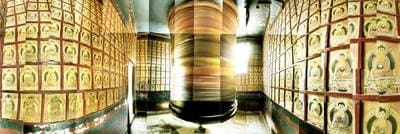Masumi Hayashi, Meditations: Two Pilgrimages
Fred and Laura Ruth Bidwell Gallery
Masumi Hayashi, Meditations: Two Pilgrimages is one of four shows in Northeast Ohio this fall celebrating the work of Cleveland artist Masumi Hayashi. Sixty years old at the time of her tragic murder in August 2006, Hayashi was one of our region’s most innovative and widely exhibited photographers with shows across the country as well as in Europe, Japan, Israel and Slovakia. This exhibition presents nine large-scale works from the artist’s last two major series.
Hayashi’s works are not traditional documentary images, which capture a single moment from one point of view. She produced photo collages, combining up to 100 smaller shots to form a large image. Photographing small “slices” of a scene, she repeatedly rotated the camera horizontally until 360° had been covered, then repeated the scan of the horizon at higher and lower levels. Assembling her collages, Hayashi overlaid and staggered the edges of the prints. By fragmenting time and space, this process suggests that our understanding of reality depends on our perspective. And perspective can change, especially over time.
Time and perspective are at the heart of Hayashi’s Internment Camp Series. During World War II, Japanese Americans and Canadians on the West Coast were unjustly confined in camps. Born in the Gila River internment camp in 1945, Hayashi remembered little about her experience. Around 1990, all surviving American internees received an apology and reparations from the government. This inspired the artist to undertake a decade-long project photographing the remains of these remote, ruined, sad places.
In the late 1990s, Hayashi’s interest began to shift from the historical to the eternal. She began a series of trips and long stays in Southeast Asia to photograph temples and ancestor worship monuments. Herself a Buddhist, Hayashi found all these spiritual places incredibly moving, their life and lushness an antidote to the still, emptied landscapes of the internment camps.
The two series in this exhibition were not just Hayashi’s last major projects, they were also her most personal work. They were not just artistic projects but also spiritual pilgrimages, one exploring a long-suppressed pain and the other offering opportunities for spiritual healing.
This exhibition is made possible by a generous gift from The Weisberger Family with additional support from Ohio Arts Council. The accompanying free catalogue has been generously underwritten by gifts from The George Gund Foundation and the Cleveland State University College of Liberal Arts and Social Sciences.

